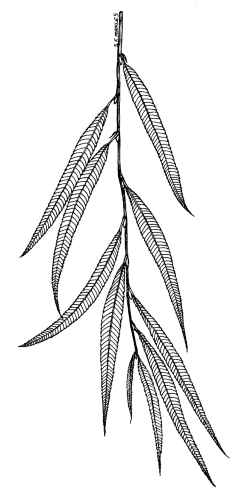Sunset®: All zones
USDA: 6-10
Sun Exposure: Full sun
Origin: China, eastern Asia
Growth Habits: Deciduous tree, 40 to 50 feet tall (12-15 m), long, graceful branches that sweep towards the ground; terminal buds lacking; grayish-brown and irregularly fissured bark; yellowish green, narrowly lanceolate, leaves, with finely serrated margin and milky green, slightly glaucous, undersides, 2.4 to 6 inches long (6-15 cm), 0.36 to 0.5 inch wide (0.9-1.2 cm)
Watering Needs: Abundant water, prefers moist soils, tolerates wet soils
Propagation: Cuttings
Propagation: Cutting
- by semi-hardwood secondary cuttings. Use intermittent mist. Root in 4-6 weeks. Cuttings should be collected during the warm season..
There are many clones available, as well as other similar species or hybrids, this has created some confusion about exact identifications.
Blooming Habits:
The weeping willow is dioecious. On both male and female trees, the flowers are upright fuzzy catkins, 0.4 to 1.6 inch long (1-4 cm), appearing before or at the same time as the leaves in the spring.
Fruiting Habits:
Light brown, valve-like capsules, 0.06 inch long (1.5 mm), in 1 inch long (2.5 cm) clusters, containing many fine, cottony seeds, in late spring to early summer.
Culture:
Willows are generally troublesome trees attacked by a variety of insects, have invasive roots and are poor neighbors for whatever you want to cultivate around them.
Desert-Tropicals is dedicated to provide gardening advice, gardening ideas, and information about flower of all kind for landscape and collections.We try to check carefully the identification of the plants on the illustrations as well as the other information from the page, but occasionally errors do occur. if you notice anything that needs to be changed please contact us.Thanks.
© 1998-2020 Philippe Faucon, All Rights Reserved.
